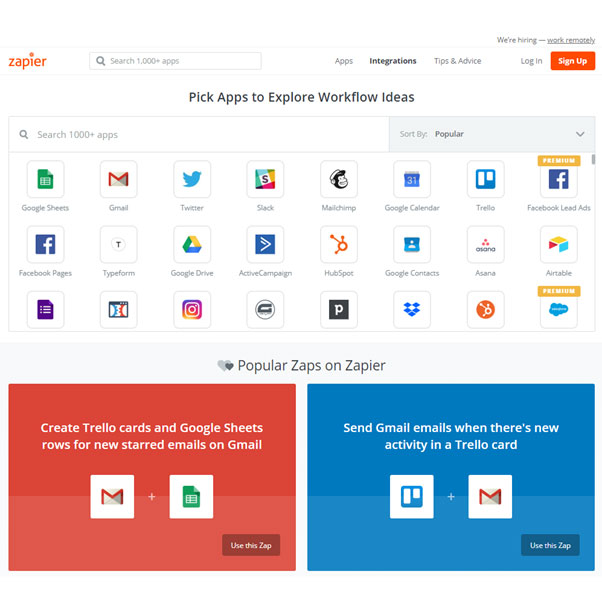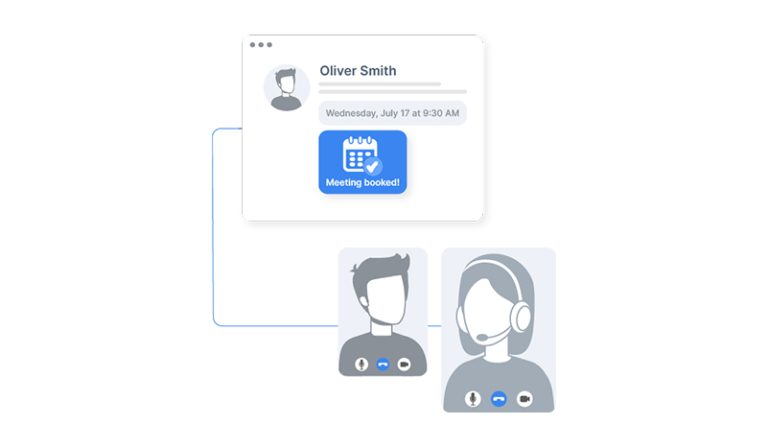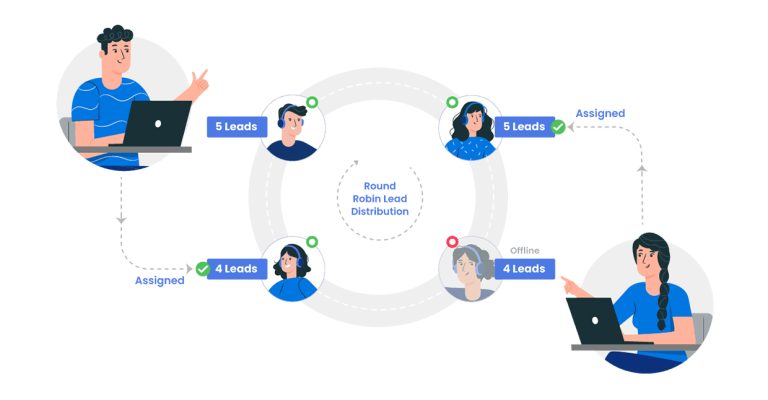Leads play a crucial role in the success of any business as they help drive potential customers and revenue.
However, many business owners need help with successful lead distribution to make sure the right people or teams within their organisation connect with the most suitable person. If not executed correctly, this can lead to missed opportunities and a decrease in overall business growth.
To combat this challenge, we’ve created this guide. Our guide is meant to provide a comprehensive understanding of lead distribution and the various strategies that can be utilised to make the process smoother and more efficient.
This guide will equip you with the knowledge needed to streamline your lead distribution process from the fundamentals to more advanced techniques.
So, let’s dive into the basics and start our journey toward more effective lead distribution.
Before we go deep into it, if you want to skip straight to it, check out our lead distribution software of-choice breakdown.
What is lead distribution?
Lead distribution means the systematic approach of directing newly acquired leads to the appropriate individual or team within an organisation. The process of lead distribution is crucial in ensuring that leads are handled by the right people, who can then engage with them in a manner that maximises the chances of conversion.
It is imperative that the correct sales representative or team is selected for each lead as leads are unique, requiring specific attention and care. This is where lead distribution comes into play, as it is essentially the art of matching each lead with the appropriate sales representative.
A well-designed lead distribution practice can help ensure that leads are effectively nurtured and converted into customers.
Therefore, lead distribution is an important step in the sales process that should not be overlooked. By selecting the right sales representative or team for each lead, you can increase the chances of closing a sale and ultimately achieve better business results.
What is Lead Distribution?
Lead Generation vs. Lead Distribution
The difference between Manual and Automated Lead distribution
Manual lead distribution strategies
Automated lead distribution strategies
Why Automate Lead Distribution?
Distributing Leads: What to Consider?
Essential Steps to Take to Implement a Lead Distribution Process
Lead Distribution Benefits
How to Measure Success?
What to Look for in Lead Distribution Software?
Top 3 Lead Distribution and Lead Conversion Tools
What Lead Distribution Process & Lead Distribution Strategy is Right for You?

Lead Generation vs. Lead Distribution
In order to comprehend the functioning of lead distribution, it is essential to first grasp the process of generating and capturing leads. That is the only proper way to truly understand lead distribution and how it works.
1. Lead generation
Lead generation is the process of attracting potential customers to your business through various inbound tactics such as publishing articles, creating videos, and providing valuable content. This can result in strangers becoming visitors to your website.

2. Lead capture
Lead capture refers to the process of converting these visitors into leads by collecting their information through forms or chatbots. This can include details such as their name, email address, company size, and location, which are then stored in your CRM or database.
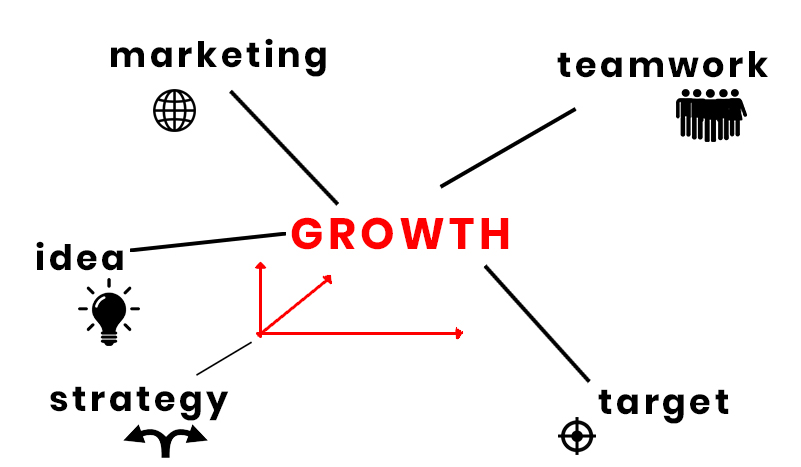
3. Lead qualification
The next step in the process is lead qualification, where the leads are evaluated based on the information gathered. This may involve reaching out to the leads to ask additional questions to determine their needs, budget, and purchasing timeline.
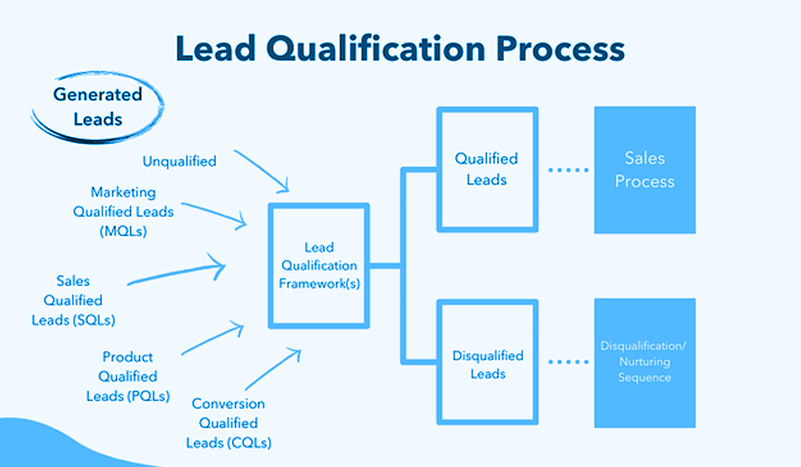
4. Lead distribution
Finally, qualified leads are distributed to sales representatives through lead distribution. The distribution method depends on the approach that you choose.
- Manual lead distribution, also known as pull-based, allows sales reps to pick up leads from the sales pool as they have time.
- Automatic lead distribution, or push-based, involves pushing prospect details and contacts into a sales rep’s queue based on established criteria.

The difference between manual and automated lead distribution
There are two main approaches to lead distribution: manual and automatic.
With manual lead distribution, sales representatives are responsible for selecting the leads they wish to pursue. This approach can be effective for smaller teams, as it allows sales reps to take ownership of their lead selection and personalise their approach.
However, as a business grows, manual lead distribution can become increasingly time-consuming and inefficient.
On the other hand, automatic lead distribution utilises automated systems to categorise leads based on factors such as location, company size, industry and more. With these systems in place, rules can be established for which sales representative will receive which type of lead.
This minimises confusion and ensures that leads are efficiently distributed to the right person.
In order to determine which lead distribution process is best for your business, it is essential to have a solid understanding of the lead distribution strategies that fall under each of these categories.
By taking the time to carefully consider your options, you can make an informed decision that will optimise your lead distribution practice and drive your business forward.

3 manual lead distribution strategies
1. Cherry-Picking:
This is a widely utilised manual lead distribution strategy, where sales representatives are allowed to choose the leads that align with their skill set, availability, and target customer base. It is entirely up to each sales rep to decide which leads they want to pursue.
2. Shark Tank:
This lead distribution method is based on speed, with all hot leads being placed in a “shark tank” and the sales rep who responds the fastest being assigned the lead. This lead distribution strategy is best suited for teams that value speed-to-lead and prioritise quickly engaging with potential customers.
3. Blind Pull:
Blind pull is a manual lead distribution strategy that operates in contrast to cherry-picking. In this approach, lead information is not disclosed to the sales rep until they have been assigned the lead. This method ensures fairness and equal distribution of leads across the sales team. By concealing lead information, sales reps are not able to cherry-pick and must instead rely on their skills and experience to successfully convert leads into customers.

3 automated lead distribution strategies
1. Round Robin:
Round Robin is an automatic lead distribution strategy where leads are assigned to sales reps in a predetermined order, based on each rep’s availability. Once a rep has been assigned a lead, it is then passed on to the next person in the line.
Sounds interesting, doesn’t it? Go one step further and check out here the power of a round robin meeting system.
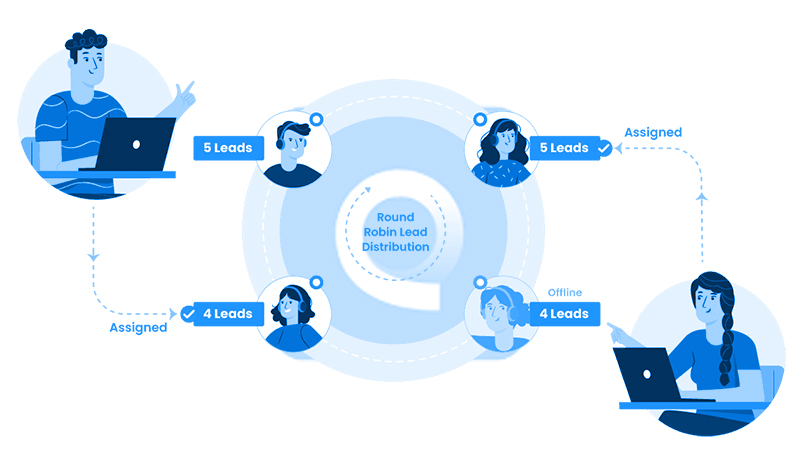
2. Weighted Distribution:
Weighted distribution is a method that takes into account the performance of each sales rep when assigning leads. Leads are distributed based on the output of each sales representative, with higher-performing reps receiving a greater number of leads.
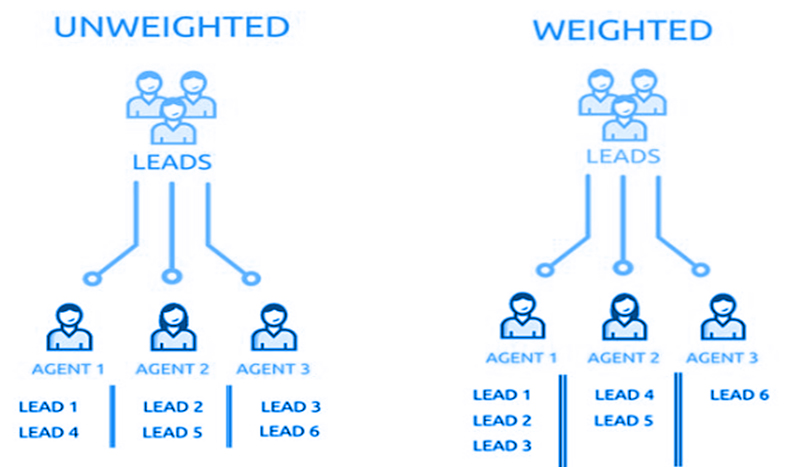
3. Proximity Distribution:
Proximity distribution is an automatic lead distribution strategy that focuses on geographical location. Leads are assigned to sales reps based on their proximity to the lead’s location, making it easier for reps to follow up with potential customers in person if necessary.
This method is only feasible if you have a team that operates in a physical location, as a remote-based team would not be able to take advantage of this approach.
3 reasons to automate lead Distribution?
As your business expands and the volume of leads increases, manual lead distribution may become impractical. Automating the process of lead distribution offers several advantages that can greatly benefit your business.
1. Efficiency
First, automation makes the sales funnel more efficient. Leads are automatically sorted into groups and assigned to the right sales representatives based on established routing rules such as availability, location, company size, etc. This eliminates the need for manual checking of multiple spreadsheets and calendars and saves valuable time for your team.
2. Better response time
Second, automating lead distribution also improves lead response time, which is critical to closing more deals and driving more revenue. Prospects who wait too long to speak with a sales rep are more likely to lose interest and look for alternative solutions.
3. Scalability
Finally, automated lead distribution is scalable and adapts easily to changes in your process. For instance, if you experience an increase in leads and decide to hire more sales representatives, you can simply add them to your system and it will automatically adjust how many leads are assigned to each rep based on the total number of reps on the team.
This ensures that your lead distribution process remains streamlined and effective, even as your business grows.
5 factors to consider when distributing leads
When it comes to lead distribution, there are several important factors to consider to ensure that leads are being distributed efficiently.
1. Expertise
The sales rep’s expertise in a specific product, service, market, or customer group is critical. Sales reps with a deeper understanding of the pain points and key benefits of the customers they serve are often better equipped to build rapport, handle objections, and close deals.
2. Experience
Closely related to expertise, experience covers all aspects of a sales rep’s job. For complex or large deals, an experienced sales rep may be required to handle them effectively.
3. Performance
Rewarding sales reps based on past performance can also play a role in lead distribution. However, it is important to balance performance-based distribution to avoid giving the best leads to only the top performers. This will help to motivate less successful reps to improve while still keeping top performers productive.
4. Geographic Location
Lead distribution based on geographic location can be beneficial for certain businesses, such as those that need to consider local laws, demographics, or requirements. For companies that require video or phone conversations with leads in different time zones, this factor can also play a role.
5. Availability
The availability of a sales rep is a key consideration for lead distribution. A rep can only work on a lead if they have the time and capacity to do so. Keeping track of a lead schedule or calendar can help to determine which reps are available to work on leads. In some cases, a sales rep’s availability may take precedence over other criteria if they are the only ones available to take a call.

6 steps to implement a lead distribution process
If you find that manually distributing leads is consuming a significant portion of your time per week, it’s time to consider automating the process with lead distribution software. Implementing such a system can be done in six straightforward steps.
1. Automate lead capturing
To ensure a seamless handoff between marketing and sales, automate the lead-capturing process. A good lead distribution tool will allow you to automatically capture new leads through a web form, sign-ups, social media messages, or support team contacts. The information will be transferred to your CRM system, notifying your sales reps.
2. Lead qualification
The next step is to automate lead qualification. You must first define the factors that will be used to qualify leads, such as business size, location, budget, decision-makers, business requirements, and more. Incoming leads will then be automatically filtered based on these factors, ensuring that only potential buyers are routed to sales reps. You can also add questions to your web form to gather more information about the leads.
3. Lead routing
After prioritising the leads, route them to the right sales reps. Set predetermined rules to determine which reps will handle which leads. Factors to consider could include experience, geographic location, performance, availability, and company size. Make sure that the reps have the resources and time to attend to the leads effectively.
4. Tool integration
If you’re setting up your first lead distribution system, make sure to integrate your lead generation tools and CRM with the lead distribution tool. This will ensure a smooth process and allow for future improvements while maintaining transparency with your team.
5. Testing
Try different lead distribution strategies, such as pull-based methods and push-based methods. Measure the KPIs and track your business performance for each strategy. Compare the results and identify what’s working well and what’s not.
6. Outcome tracking
Your work doesn’t end with setting up the lead distribution system. Track and measure the results consistently, using metrics such as call durations, response time, first call reach rate, conversion rate, close rate, and revenue increase rate. Doing so will provide early indications of any issues and allow you to make necessary adjustments.

4 benefits of lead Distribution
Are you still hesitant about the use of automated lead distribution? If so, it’s time to consider the numerous benefits that come with lead distribution software.
Here are just a few of the advantages that you can gain from using this technology.
1. Increased efficiency
Lead distribution software streamlines the lead management process and saves you a significant amount of time and resources. When leads come in, they are automatically assigned to the relevant sales reps in real time, reducing the need for manual data entry and spreadsheet tracking. Additionally, the software includes features like automated data collection, CRM integrations, routing, reporting, and analytics, all of which further enhance the speed and efficiency of your lead management process.
2. Improved conversion rates
Implementing lead distribution software can help you generate more inbound leads and build trust with your prospects. The system simplifies the sales funnel, allowing your sales reps to focus on preparing for and engaging with leads. By giving them the time and resources to build strong relationships with prospects, you increase the chances of turning them into customers, which in turn boosts your overall business revenue.
3. Reduced manual errors
As your business grows, it can become challenging to maintain accurate records of your qualified leads. Using lead distribution software eliminates the risk of manual errors and ensures that lead management processes are automated and accurate. The software makes it easier for your sales reps to track leads and ensures that the right leads are being assigned to the right salespeople.
4. Enhanced customer experience
Lead distribution software plays a critical role in improving your customer experience. By assigning leads to the best-suited sales reps, you ensure that your prospects receive high-quality interactions from the very beginning. By using the right routing rules, you can make sure that leads are being assigned to the salespeople who are best equipped to handle them. Furthermore, advanced lead distribution tools notify salespeople of incoming leads, allowing them to prepare and offer a great customer experience.

3 ways to measure Success?
Let’s walk you through the most important metrics that you need to keep an eye on if you want to measure success properly.
1. Quantity
When it comes to sales performance, both the quantity and quality of calls made are important indicators. While it’s true that quality is more important than quantity, it’s still crucial to keep track of the number of calls made by your sales reps. If you notice that one sales rep is consistently making fewer calls compared to others, it may be time to implement intervention measures.
2. Duration
Call duration is another key metric to track. This metric reveals a lot about your sales process. If the call duration is longer, it suggests that your sales rep has targeted the right group of people who are more likely to ask more questions because your solution can solve their business problems.
Additionally, call duration also indicates the effectiveness of your sales rep. Sales reps who are good at their job will be able to keep the conversation going and keep the leads engaged.
3. Can they close a deal?
The number of deals closed is another key metric that speaks for itself. This metric shows the overall performance of your sales team and how well they are able to close deals.
If this metric is underperforming, it may be a sign that your sales rep is not the right fit to handle leads of a particular profile, and you may want to reassess your lead routing rules. By analysing these metrics, you can make informed decisions to optimise your sales processes.

5 features to Look for in lead distribution software?
We’ve established that choosing the best lead distribution software is a critical decision for businesses that want to streamline their sales processes and increase their efficiency.
There are several factors that need to be taken into consideration when selecting the right software. Here are some of the most important ones:
1. Round Robin
Round robin offers a fair system of lead distribution to multiple sales reps, where the order is systematically cycled through. For example, if you have 5 sales representatives in your team, each rep will receive one turn for a lead when it comes their way based on the predetermined queue. This cycle begins again at last name in line once all five reps have had their shot.
You can easily change your sales reps’ schedules to accommodate new leads, even when they are taking some much-needed time off.
2. CRM integrations
Lead distribution software that can integrate with other tools, such as customer relationship management (CRM) software, is more effective.
This eliminates manual data entry and reduces the possibility of human error. Integrating with CRM software, such as Hubspot or Salesforce, streamlines the lead management process and provides a centralised location for all lead information.
3. Detailed reporting and analytics
It is essential to choose a lead distribution software that provides detailed reporting and analytics.
This information provides in-depth insight into the leads and the performance of sales reps. Reports should include information on the total number of leads, the number of leads accepted or declined by each rep, and the average response times.
This information helps businesses understand the quality and quantity of deals each rep is closing for each type of lead, and identify any areas for improvement.
4. Feedback capture
A feedback capture feature is critical for businesses that want to keep track of what happens to leads once they are accepted by a sales rep.
Some software solutions will prompt reps for an update in the form of a survey, while others allow reps to leave comments.
This information provides businesses with insight into the progress and quality of leads, enabling them to make necessary modifications to their lead management strategy to optimize sales processes.
5. Rules based lead routing
Lead distribution software should have a rules-based lead routing feature that assigns leads to the most appropriate reps based on predefined criteria.
This prevents leads from being mismatched with reps and helps ensure that the lead is addressed by a rep who is best suited to solve their business problems.
3 best lead distribution tools
Let’s take a look at some of the most important lead distribution tools available at the moment.
1. QikChat
If you’re searching for a tool that can streamline the process automatically assigning one of your team members to the lead, whilst at the same time, sending their scheduling link to a lead, ready for the lead to click once and book in a time, QikChat is among the best choices out there.
This lead distribution tool is specifically designed for businesses that generate inbound leads from their marketing efforts, by intercepting leads at the point where they fill out a webform, removing the need to take the lead to a separate landing page to select a time, where the availability schedule of the team member is sent to them straight away.
QikChat eliminates the tedious friction points to maximise the value of your leads by reducing the time from lead form completion to first meeting scheduled.
Additionally, QikChat is introducing new features to facilitate everything needed to maximise the value of each inbound lead received and provide unparalleled insights around your sales process.
2. HubSpot
HubSpot is a powerful CRM tool that features a robust lead routing function. Providing pre-set rules, this enables businesses to efficiently route leads to the most suitable representative, ensuring that your sales process runs smoothly and efficiently.
Its lead distribution feature starts by gathering essential information from leads through web forms.
Careful though, it’s not as simple as it may sound, you’ll need to set up Hubspot workflows that match the contact properties of the webforms you are capturing your leads from, if your an advanced HubSpot user, you might just be able to set this up.
3. LeadSquared
LeadSquared is an all-in-one marketing automation and CRM platform that includes a built-in lead distribution automation feature. This function allows you to assign leads to sales reps based on customizable rules, which can even be set for individual reps.
In addition to its lead distribution capabilities, LeadSquared also comes equipped with lead capture and qualification features, making it a comprehensive solution for streamlining your lead management process.
What Lead Distribution Process & Lead Distribution Strategy is Right for You?
Take the time to evaluate your business needs and choose a lead distribution strategy that best fits your goals and objectives. With the right approach, you can streamline your lead distribution process and ensure that your leads are in the best hands possible.
Just remember that automating the lead distribution practice through software will enhance the responsiveness of your sales representatives, enabling the growth of your business and delivering an exceptional customer experience.
Last but not least, when starting out, it’s important for your team to evaluate your organisation’s strengths and weaknesses to determine the most effective lead distribution method. Once you have identified a method that fits your organisation, you can test and refine your approach through iteration.
This will ensure that your sales reps are consistently serving the right customers and improving the overall performance of your team.


